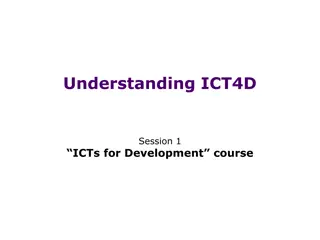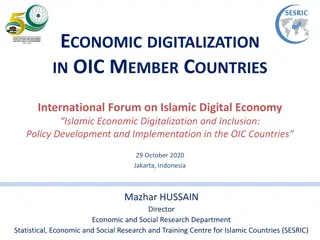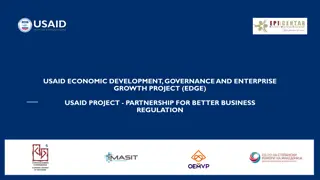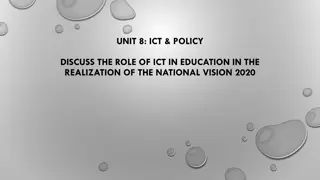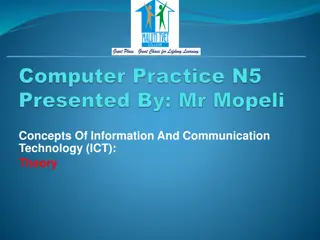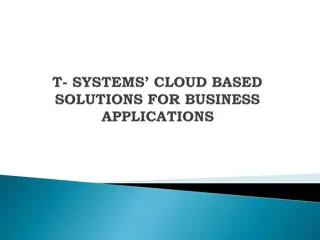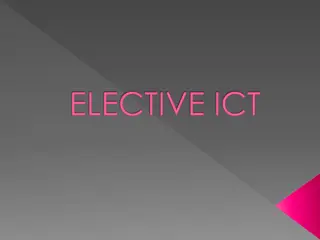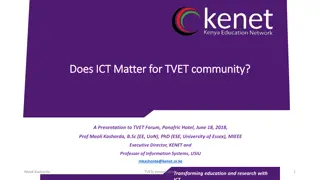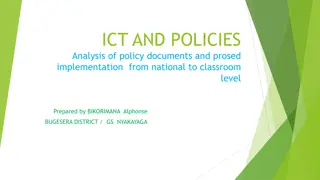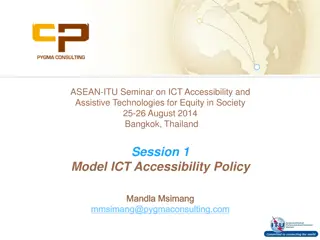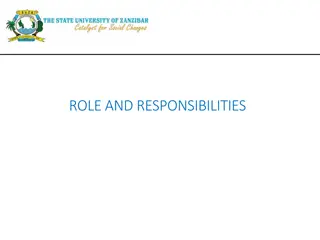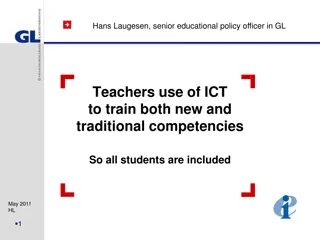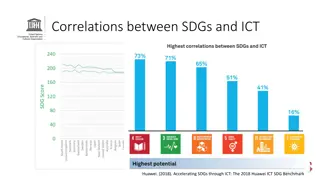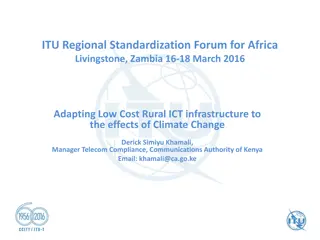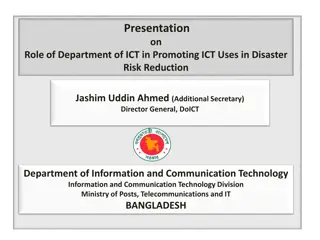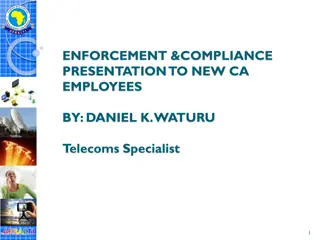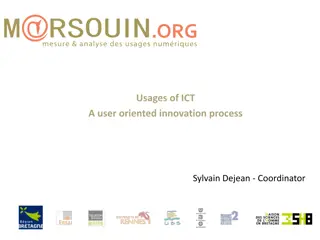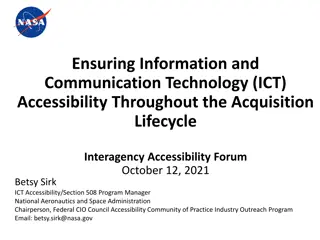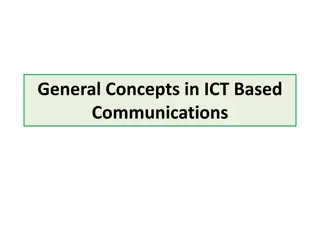Understanding Security Management in an ICT Environment
Security management in an ICT environment involves organizing and controlling resources in a business enterprise to mitigate network threats and vulnerabilities. This comprehensive overview covers the foundations of security, information security policies, enforcing security, and ensuring business continuity. It emphasizes the importance of confidentiality, integrity, and availability in securing hardware, software, data, and communications.
Download Presentation

Please find below an Image/Link to download the presentation.
The content on the website is provided AS IS for your information and personal use only. It may not be sold, licensed, or shared on other websites without obtaining consent from the author. Download presentation by click this link. If you encounter any issues during the download, it is possible that the publisher has removed the file from their server.
E N D
Presentation Transcript
Security Management in an Security Management in an ICT Environment ICT Environment Organizing and Controlling Resources in the Business Enterprise.
Overview Overview Part A: What Security Is Introduction Foundations of Security Network Threats and Vulnerabilities Mitigating Network Threats and Vulnerabilities Part B: Information Security Policy And Procedures Introduction Security Controls Policies, Procedures and People Data Sensitivity and Classification of Information Part C: Enforcing Security Implementing Security Applications Part D: Ensuring Business Continuity Contingency and Disaster Recovery Incidence Response and Reporting
Part A: What Security Is Part A: What Security Is Introduction Foundations of Security Network Threats and Vulnerabilities Mitigating Network Threats and Vulnerabilities
Introduction Introduction Security is a key aspect of today s world especially in the business place. Prior to this present day, it has often been overlooked or ignored but has proven otherwise. Security is not just personnel, an application or a piece of hardware, it is a combination of several many techniques and technologies. Security has to do with controlling access to resources/ assets which can be any of software, data, computers, structures and/or personnel. Over the years, as technology evolves, the need to secure such as become of concern. Managing security processes (which is any of setup, testing, enforcement and updating of techniques and technologies) in an organization is the focus of this group of learning resource.
Introduction Introduction There is no such thing as complete or total security ; any information system, website, data, computer or network is only as secure as it is designed, used or as secure as measures put in place to protect such resource(s).
Foundations of Security Foundations of Security One key fact to note about security is that nothing (computers, networks, software and personnel alike) is completely secure. Total security is a myth. Having taken note of this, IT professionals & Security administrators rely on three key principles to protect organizations hardware, software, data and communications thus: Confidentiality Integrity Availability These three principles should be applied whenever dealing with the security of hardware, software, or communications. They should be foremost in the mind of a security administrator.
Foundations of Security Foundations of Security - - Confidentiality Confidentiality Is preventing the disclosure of information to unauthorized persons. For the public it signifies driver license information, national identity card (or other country specific identification), bank accounts and passwords, and so on. For organizations this can include all the preceding information, but it actually denotes the confidentiality of data. To make data confidential, the organization (not just the security professionals) must work hard to make sure that it can be accessed only by authorized individuals. How to accomplish this is highlighted throughout the workshop.
Foundations of Security Foundations of Security - - Confidentiality Confidentiality For example, when you re about logging into a website online, the characters of your password are encrypted with a strong cipher so that the password cannot be compromised. Next time you login to your account online, take a look at how the password is being kept confidential. As a security professional, confidentiality should be your number one goal. In keeping data confidential, you remove threats, absorb vulnerabilities, and reduce risk.
Foundations of Security Foundations of Security - - Integrity Integrity This means that data has not been tampered with be it stored or in transit. A data integrity solution might perform origin authentication to verify that traffic is originating from the source that should send the traffic. Authorization is necessary before data can be modified in any way to protect the data s integrity. There should have been permissions in place to stop the person from deleting the file. For example, if a person were to delete a required file, either maliciously or inadvertently, the integrity of that file will have been violated.
Foundations of Security Foundations of Security - - Integrity Integrity Common integrity violations include the following: Modifying the appearance of a corporate website Intercepting and altering an e-commerce transaction Modifying financial records that are stored electronically
Foundations of Security Foundations of Security - - Availability Availability Securing computers and networks can be a strain on resources. Availability means that data is obtainable regardless of how information is stored, accessed, or protected. The availability of data is a measure of the data s accessibility. It also means that data should be available regardless of the malicious attack that might be perpetrated on it. For example, if a server was down only 5 minutes per year, the server would have an availability of 99.999 percent (that is, the five nines of availability ).
Foundations of Security Foundations of Security - - Availability Availability Instances of how an attacker could attempt to compromise the availability of a network include the following: Send improperly formatted data to a networked device, resulting in an unhandled exception error. Flood a network system with an excessive amount of traffic or requests, which would consume a system s processing resources and prevent the system from responding to many legitimate requests. This type of attack is referred to as a denial of service (DoS) attack.
Foundations of Security Foundations of Security AAA Another acronym to keep in mind is the AAA of computer security: authentication, authorization, and accounting. Authentication - When a person s identity is established with proof and confirmed by a system. Typically, this requires a digital identity of some sort, username/password, or other authentication scheme. Authorization - When a user is given access to certain data or areas of a building.Authorization happens after authentication and can be determined in several ways including permissions, access control lists, time-of-day, and other login restrictions and physical restrictions. AAA
Foundations of Security Foundations of Security AAA Accounting Often accounting means logging, auditing, and monitoring of the data and resources. Accountability is quickly becoming more important in today s secure networks. Part of this concept is the burden of proof. You as the security person must provide proof if you believe that someone committed an unauthorized action. When you have indisputable proof of something users have done and they cannot deny it, it is known as non- repudiation. This AAA concept should also be applied to any security plan you develop. But it goes further than this. There are authentication protocols based on the concept of AAA such as RADIUS, TACACS, and TACACS+ AAA
Network Threats and Vulnerabilities Network Threats and Vulnerabilities Technology is neutral, its use makes it good or bad. With the advent of networks and its related technologies several issues have surfaces and are discussed in this segment. Modern systems are accessed by PCs, which are inherently more vulnerable to security risks and difficult to control. It is hard to control physical access to each PC. PCs are portable, and if they are stolen, the data and access capabilities go with them. PC users tend to be more oblivious to security concerns.
Network Threats and Vulnerabilities Network Threats and Vulnerabilities Network Threats are activities or programs that can alter or disrupt the normal functioning of a program, website, hardware, computer or process(es) and access to stored data or other resources. Threats to business networks are outlined thus: Malicious Software (Malware): Can be any of virus, worm, rootkit, trojan horse or grayware. Any set of instructions that alters the normal functions of a computer for destructive and malicious reasons such as theft or fraud. Malware can execute its payload e.g. deleting files with (virus, grayware) or without (worm, rootkit, trojan horse) the actions of the user. Often transferred via email, Instant Message, websites or infected media.
Network Threats and Vulnerabilities Network Threats and Vulnerabilities Malicious Software (Malware) Malware Threat Definition Example Virus Code that runs on a computer without the user s knowledge; it infects the computer when the code is accessed and executed. Similar to viruses except that it self replicates, whereas a virus does not. Love Bug virus Ex: love-letter-for- you.txt.vbs Worm Nimda Propagated through network shares and mass e-mailing Remote access Trojan Ex: SubSeven malware application Internet Optimizer (aka DyFuCA) Trojan horse Appears to perform desired functions but actually is performing malicious functions behind the scenes. Malicious software either downloaded unwittingly from a website or installed along with some other third-party software. Software designed to gain administrator-level control over a computer system without being detected. Spyware Rootkit Boot loader rootkits Ex: Evil Maid Attack
Network Threats and Vulnerabilities Network Threats and Vulnerabilities Spam: Unsolicited messages (Instant Messages, emails) that carry keywords not acceptable (blacklisted) and/or have malware within them and links to malware. Attacks: The proactive activity (or group of activities) of accessing and/or taking over control of a resource in a program, website, computer or network. Can be any of Confidentiality attacks, Integrity attacks (a.k.a. man-in-the middle attack), data diddling (using worm, virus etc.), trust relationship exploitation, password attack (using keyloggers or trojan horse), privilege escalation, brute force or session hijacking etc.
Network Threats and Vulnerabilities Network Threats and Vulnerabilities Unauthorized access: Access to computer resources and data without consent of the owner. It might include approaching the system, trespassing, communicating, storing and retrieving data, intercepting data, or any other methods that would interfere with a computer s normal work. Access to data must be controlled to ensure privacy. Improper administrative access falls into this category as well. System failure: Computer crashes or individual application failure. This can happen due to several reasons, including user error, malicious activity, or hardware failure.
Network Threats and Vulnerabilities Network Threats and Vulnerabilities Social Engineering: is the act of manipulating users into revealing confidential information or performing other actions detrimental to the user. Examples of social engineering are common in everyday life. A basic example would be a person asking for your username and password over the phone; often the person uses flattery to gain the information she seeks. Malicious people use various forms of social engineering in an attempt to steal whatever you have of value: your money, information, identity, confidential company data, or IT equipment.
Network Threats and Vulnerabilities Network Threats and Vulnerabilities Social engineering experts use techniques such as bold impersonation, company jargon, embedding of questions, grooming trust, persistence and patience, and even emergency to gain their ends. They use tools such as social networking sites and P2P software to obtain information disclosure. The main reason that social engineering succeeds is due to lack of user awareness. Social engineering can also be effective in environments in which the IT personnel have little training and in public areas, for example, public buildings with shared office space.
Network Threats and Vulnerabilities Network Threats and Vulnerabilities Below are some of the more common types of social engineering: Type Pretexting Description When a person invents a scenario, or pretext, in the hope of persuading a victim to divulge information. When a thief attempts to take responsibility for a shipment by diverting the delivery to a nearby location. The attempt at fraudulently obtaining private information, usually done electronically. Vishing is done by phone. Spear phishing targets specific individuals. Whaling targets senior executives. The attempt at deceiving people into believing something that is false. When a person uses direct observation to find out a target s password, PIN, or other such authentication information. Diversion theft Phishing Hoax Shoulder surfing
Network Threats and Vulnerabilities Network Threats and Vulnerabilities Type Description Eavesdropping When a person uses direct observation to listen in to a conversation. This could be a person hiding around the corner or a person tapping into a phone conversation. Dumpster diving information in garbage and recycling containers. Baiting When a malicious individual leaves malware-infected removable media such as a USB drive or optical disc lying around in plain view in the hopes that unknowing people will bring it back to their computer and access it. Piggybacking/ Tailgating authorized person to gain entry to a restricted area. When a person literally scavenges for private When an unauthorized person tags along with an
Network Threats and Vulnerabilities Network Threats and Vulnerabilities Vulnerabilities are weaknesses/ flaws in the design of a program, website or device that can be used to take advantage of such resource or resources linked to it. Common known vulnerabilities are poor or insecure programming, open backdoors, lack of security policies, lack of updates.
Mitigating Network Threats and Mitigating Network Threats and Vulnerabilities Vulnerabilities There are several ways to prevent and help recover from the previous threats they include: User Education and Awareness: The wiser the user, the less chance of security breaches. Employee training and education, easily accessible and understandable policies, security awareness e- mails, and online security resources all help to provide user awareness. These methods can help to protect from all the threats mentioned previously. Although it can only go so far while remaining cost effective and productive, educating the user can be an excellent method when attempting to protect against security attacks.
Mitigating Network Threats and Mitigating Network Threats and Vulnerabilities Vulnerabilities User education and awareness training are the keys to helping reduce social engineering success. The following is a basic list of rules you can use when training employees: Never, under any circumstances, give out any authentication details such as passwords, PINs, company ID, and so on. Always shield keypads and screens when entering authentication information. Always screen your e-mail and phone calls carefully and keep a log of events. Use encryption when possible to protect e-mails and phone calls. Never pick up, and make use of, any removable media. Always track and expedite shipments.
Mitigating Network Threats and Mitigating Network Threats and Vulnerabilities Vulnerabilities If there is any doubt as to the legitimacy of a person, e- mail, or phone call, document the situation and escalate it to your supervisor, security, or the authorities. Always shred any sensitive information destined for the garbage or recycling. When training employees, try to keep them interested; infuse some fun and examples. Use examples of social engineering so that your trainees can make the connection between actual social engineering methods and their defenses. Make them understand that social engineers don t care how powerful an organization s firewall is or how many armed guards the company has. They get past technology and other types of security by exploiting the weaknesses inherent in human nature.
Mitigating Network Threats and Mitigating Network Threats and Vulnerabilities Vulnerabilities Authentication: The verification of a person s identity that helps protect against unauthorized access. It is a preventative measure that can be broken down into four categories: Something the user knows, for example a password or PIN Something the user has, for example a smart card or other security token Something the user is, for example, the biometric reading of a fingerprint or retina scan Something a user does, for example, voice recognition or a written signature
Mitigating Network Threats and Mitigating Network Threats and Vulnerabilities Vulnerabilities Antimalware software: Protects a computer from the various forms of malware, and if necessary, detects and removes them. Types include antivirus and antispyware software. Well-known examples include programs from Avast, Symantec and McAfee, as well as Windows Defender and Spyware Doctor. Nowadays, a lot of the software named antivirus can protect against spyware and other types of malware as well.
Mitigating Network Threats and Mitigating Network Threats and Vulnerabilities Vulnerabilities Data backups: Data backup is an important part of security. Backups won t stop damage to data, but they can enable you to recover data after an attack or other compromise, or system failure. From programs such as Windows Backup and Restore Center, NTbackup, and Bacula to enterprise-level programs such as Tivoli and Veritas. Note that fault-tolerant methods such as RAID are good preventative measures against hardware failure but might not offer protection from data corruption or erasure.
Mitigating Network Threats and Mitigating Network Threats and Vulnerabilities Vulnerabilities Encryption: The act of changing information using an algorithm known as a cipher to make it unreadable to anyone except users who possess the proper key to the data. Examples of this include AES-encrypted wireless sessions, HTTPS web pages, and PGP- encrypted e-mails.
Mitigating Network Threats and Mitigating Network Threats and Vulnerabilities Vulnerabilities Data removal: Proper data removal goes far beyond file deletion or the formatting of digital media. The problem with file deletion/formatting is data remanence, or the residue, left behind, from which re-creation of files can be accomplished by some less-than- reputable people with smart tools. Companies typically employ one of three options when met with the prospect of data removal: clearing, purging (also known as sanitizing), and destruction.
Part B: Information Security Part B: Information Security Policy And Procedures Policy And Procedures Introduction Security Controls Policies, Procedures and People Data Sensitivity and Classification of Information
Introduction Introduction By combining a well-thought-out security plan with strong individual security methods, a security professional can effectively stop threats before they become realities, or at the least, in worst-case scenarios, recover from them quickly and efficiently. The strongest security plans take many or all of these methods and combine them in a layering strategy known as defense in depth , which can be defined as the building up and layering of security measures that protect data throughout the entire life cycle starting from inception, on through usage, storage and network transfer, and finally to disposal.
Security Controls Security Controls Many information security technologies and concepts can protect against, or help recover from, the preceding threats. The question is does your organization have the resources to implement them? Even on a low budget the answer is usually yes. It all starts with planning, which is effectively free. In general, a security administrator should create a proactive security plan that usually starts with the implementation of security controls. When creating the security plan, some IT professionals divide the plan into three categories of controls as follows:
Security Controls Security Controls Physical: Things such as alarm systems, surveillance cameras, locks, ID cards, security guards, and so on. Technical: Items such as smart cards, access control lists (ACLs), encryption, and network authentication. Administrative: Various policies and procedures, security awareness training, contingency planning, and disaster recovery plans (DRPs). Administrative controls can also be broken down into two subsections: procedural controls and legal/regulatory controls. These information security controls are used to protect the confidentiality, integrity, and availability, or CIA of data.
Policies, Procedures and People Policies, Procedures and People Environmental Controls: Although it is usually the duty of the IT director and building management to take care of the installation, maintenance, and repair of environmental controls, you also should have a basic knowledge of how these systems function. Significant concepts include: Fire suppression HVAC (Heating, Ventilation and Air Conditioning) Shielding of equipment. Workplace safety. By far, the concept a person would spend the most time dealing with when planning a server room is fire suppression.
Policies, Procedures and People Policies, Procedures and People Legislative and Organizational Policies: There are myriad legislative laws and policies. We will look at a few that affect, and protect, the privacy of individuals. In this section, we cover those and some associated security standards. More important for are organizational policies. Organizations usually define policies that concern how data is classified, expected employee behavior, and how to dispose of IT equipment that is no longer needed. These policies begin with a statement or goal that is usually short, to the point, and open-ended. They are normally written in clear language that can be understood by most everyone. They are followed by procedures (or guidelines) that detail how the policy will be implemented.
Policies, Procedures and People Policies, Procedures and People Policy Procedure Employees will identify themselves in a minimum of two ways when entering the complex. 2. In the guard room, they must prove their identification in two ways: By showing their ID badge to the on-duty guard. By being visible to the guard so that the guard can compare their likeness to the ID badge s photo. The head of the employee should not be obstructed by hats, sunglasses, and so on. In essence, the employee should look similar to the ID photo. If the employee s appearance changes for any reason, that person should contact human resources for a new ID badge. 1. When employees enter the complex, they will first enter a guard room. This will begin the authentication process.
Policies, Procedures and People Policies, Procedures and People Policy Procedure * If guards cannot identify the employee, they will contact the employee s supervisor, human resources, or security in an attempt to confirm the person s identity. If the employee is not confirmed, they will be escorted out of the building by security. 3. After the guard has acknowledged the identification, employees will swipe their ID badge against the door scanner to complete the authentication process and gain access to the complex.
Policies, Procedures and People Policies, Procedures and People Keep in mind that this is just a basic example; technical documentation specialists will tailor the wording to fit the feel of the organization. Plus, the procedure will be different depending on the size and resources of the organization and the type of authentication scheme used, which could be more or less complex. However, the policy (which is fairly common) is written in such a way as to be open-ended, allowing for the procedure to change over time.
Policies, Procedures and People Policies, Procedures and People Policy Types: We talk about many different policies as follows: Data Sensitivity and Classification of Information (ISO/IEC 27002:2005) Personal Security Policies
Data Sensitivity and Classification of Data Sensitivity and Classification of Information Information Sensitive data is information that can result in a loss of security, or loss of advantage to a company, if accessed by unauthorized persons. Often, information is broken down into two groups: classified (which requires some level of security clearance) and non-classified. ISO/IEC 27002:2005 (which revises the older ISO/IEC 17799:2005) is a security standard that among other things can aid companies in classifying their data.
Data Sensitivity and Classification of Data Sensitivity and Classification of Information Information Data Sensitivity Classifications Class Description Public information Information available to anyone. Internal information Used internally by a company, but if it becomes public, no critical consequences result. Confidential information and operational loss to the company. Secret information Data that should never become public and is critical to the company. Top secret information The highest sensitivity of data, few should have access, security clearance may be necessary. Information is broken into sections on a need-to- know basis. Information that can cause financial
Data Sensitivity and Classification of Data Sensitivity and Classification of Information Information In the classification earlier mentioned, loss of public and internal information probably won t affect the company very much. However, unauthorized access, misuse, modification, or loss of confidential, secret, or top secret data can affect users privacy, trade secrets, financials, and the general security of the company. By classifying data and enforcing policies that govern who has access to what information, a company can limit its exposure to security threats. Many companies need to be in compliance with specific laws when it comes to the disclosure of information.
Policies, Procedures and People Policies, Procedures and People Personal Security Policies
Policies, Procedures and People Policies, Procedures and People An organization often has in-depth policies concerning vendors. Issues often occur because the level of agreement between an organization and the vendor was not clearly defined. A proper service level agreement (SLA) that is analyzed by the organization carefully before signing can be helpful. A basic service contract is usually not enough; a service contract with an SLA will have a section within it that formally and clearly defines exactly what a vendor is responsible for and what the organization is responsible for a demarcation point so to speak. It might also define performance expectations and what the vendor will do if a failure of service occurs, timeframes for repair, backup plans, and so on.
Policies, Procedures and People Policies, Procedures and People To benefit the organization, these will usually be legally binding and not informal. Due to this, it would benefit the organization to scrutinize the SLA before signing, and an organization s attorney should be involved in that process. For instance, a company might use an ISP for its T3 connection. The customer will want to know what kind of fault-tolerant methods are on hand at the ISP and what kind of uptime they should expect, which should be monitored by a network admin.
Policies, Procedures and People Policies, Procedures and People The SLA might have some sort of guarantee of measurable service that can be clearly defined. Perhaps a minimum level of service and a target level of service. Before signing an SLA such as this, it is recommended that an attorney, the IT director, and other organizational management review the document carefully and make sure that it covers all the points required by the organization.
Part C: Enforcing Security Part C: Enforcing Security Implementing Security Applications










 undefined
undefined






